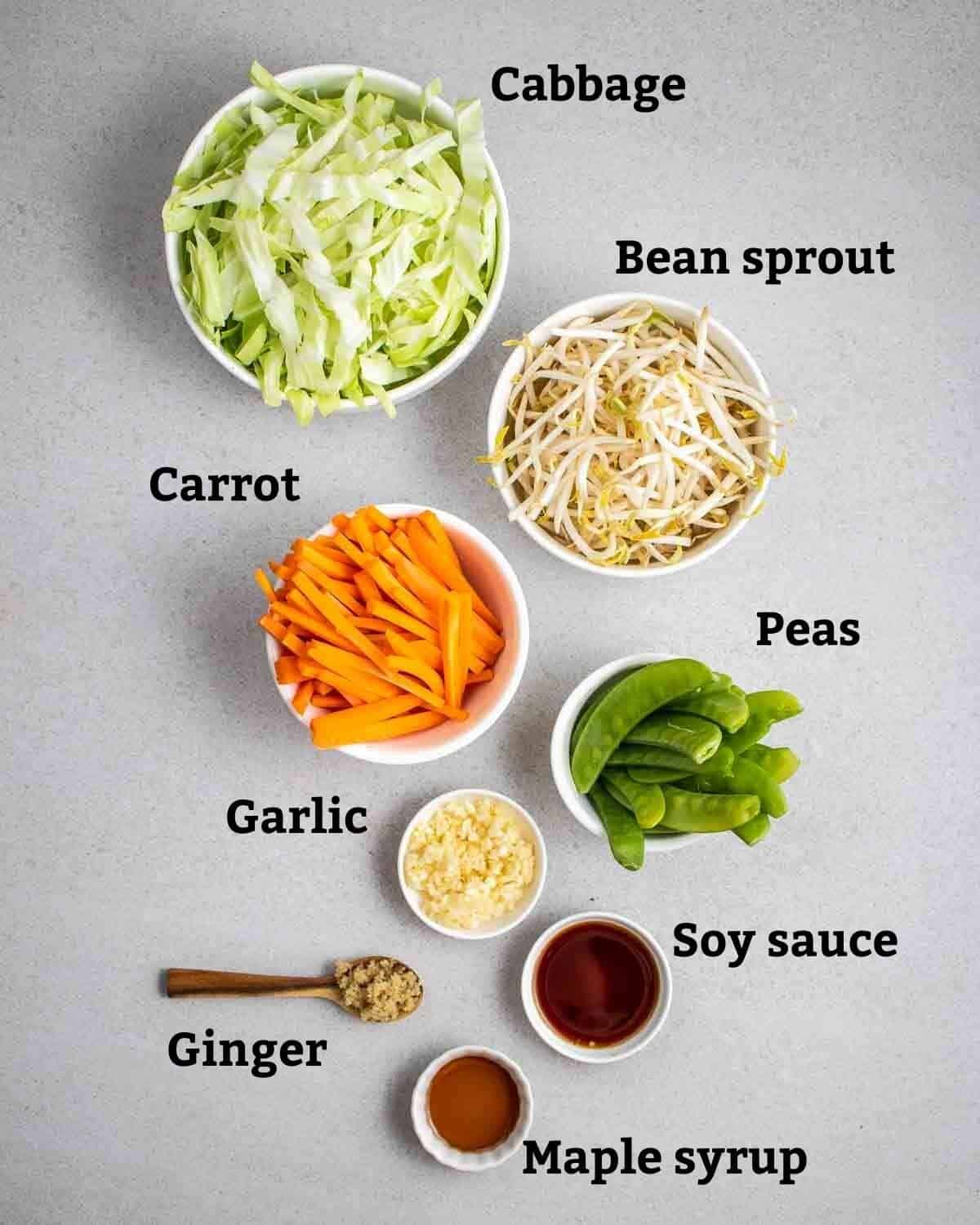Yasai Itame, or Japanese stir-fried vegetables, is a flavorful yet light dish that is great served with a side of rice or cooked noodles. A simple recipe that takes 20 minutes to prepare and requires minimal prep!

Yasai Itame is a popular Japanese stir-fry vegetable dish, usually consisting of a mix of vegetables and meat seasoned with soy sauce, oyster sauce, and sesame oil.
This dish is the perfect weeknight meal when I am craving vegetables! It is packed with flavors, delicious yet refreshing. It makes a great quick dinner when paired with rice, noodles, or some silky vegan basic congee.
To make a heartier meal, you could also serve it with Japanese mains like Japanese tofu curry, baked teriyaki tofu or sushi rolls like my avocado maki!
🥬What you will need

📃Ingredients notes and substitutions
- Soy sauce - Japanese soy sauce works best in this recipe. You can substitute it with regular soy sauce, tamari, or shoyu.
- Maple syrup - Feel free to substitute it with other sweeteners like cane sugar, brown sugar, or agave syrup.
- Oyster sauce (not pictured) - A small amount will greatly enhance the umami flavor of this dish. Use a mushroom-based vegetarian oyster sauce to keep this recipe vegan.
🔪How to make

- Step 1: Heat a non-stick wok, and start by frying garlic and ginger until fragrant.

- Step 2: Add carrot, and cook for 2-3 minutes or until they soften slightly.

- Step 3: Then, add cabbage to the pan and fry for 1-2 minutes.

- Step 4: Add bean sprouts and snow peas. Cook for a couple of minutes until veggies are cooked.
💡Tip
Do not overcook vegetables, you will want them to retain their crunch and not be overly soft and mushy.

- Step 5: Pour in stir-fry sauce and toss until it is well incorporated. Season with salt and pepper.

- Step 6: Serve yasai itame with rice or noodles.
✔Helpful tips
- Drain washed veggies thoroughly - Excess water from washed vegetables will cause stir-fry to turn soggy.
- Use a large enough non-stick wok or pan - This ensures that veggies are cooked properly. An overcrowded pan will cause ingredients to steam rather than fry.
- Switch up the vegetables - Feel free to switch up the vegetables with whatever you have on hand. Some great choices include bell peppers, mushrooms, baby corn, and broccoli florets.
- Add a source of protein - Traditionally, thinly sliced pork or beef are commonly added. You could also de diced chicken or shrimp. For those who are plant-based, I recommended adding pan-fried tofu, seitan chicken, or some thinly sliced vegan sausage.
Save this recipe!
Also get a FREE high-protein vegan recipe eBook + weekly new recipes! Unsubscribe anytime.

🍚How to serve
Toppings - For more flavor and texture, garnish your yasai itame with chili flakes, chopped green onion or cilantro, fried garlic chips, or Japanese pickled vegetables like pickled radish.
Rice - This dish will go with any rice, particularly Japanese rice or Jasmine rice. You could also pair it with some homemade onigiri or cucumber maki.
Noodles - My tofu yakisoba or miso ramen pairs great with this recipe.
❄️Storing suggestions
Fridge - Leftover Japanese stir-fry vegetables can be refrigerated for 3-4 days. Reheat it on the stove or microwave before serving. Take care not to heat it for too long to prevent veggies from softening too much.
Freezer - This recipe is unsuitable for freezing.

📖 Recipe

Yasai Itame (Japanese Stir-fry Vegetables)
Equipment
- non-stick wok or large non-stick pan
Ingredients
Stir-fry sauce
- 1 tablespoon soy sauce or tamari/shoyu (use gluten-free if needed)
- 2 teaspoon sesame oil
- 1 teaspoon maple syrup or another liquid sweetener
- 1 teaspoon oyster sauce or vegetarian oyster sauce
Other ingredients
- 3 cloves garlic minced
- 1 teaspoon minced ginger
- 1 medium carrot julienned
- 4 cups shredded cabbage
- 2 cups bean sprout
- 1 cup snow peas
- salt and pepper to taste
Instructions
- Start by combining all ingredients needed for the sauce and mix well. Set aside.1 tablespoon soy sauce, 1 teaspoon maple syrup, 2 teaspoon sesame oil
- Heat up a tablespoon of oil in a non-stick wok or pan over medium-high heat. Once it is heated, add garlic and ginger in. Fry for a minute until fragrant.3 cloves garlic, 1 teaspoon minced ginger
- Add carrot in next, and cook for 2-3 minutes, or until it has softened slightly.1 medium carrot
- Then, stir in cabbage. Let it fry for 1-2 minutes, before adding in bean sprouts and snow peas. Stir-fry for a couple of minutes until veggies are cooked.4 cups shredded cabbage, 2 cups bean sprout, 1 cup snow peas
- Lastly, pour in stir-fry sauce and toss until everything is well incorporated. Add salt and pepper to taste. Serve and enjoy it while hot!
Notes
- Do not overcook vegetables - You will want them to retain their crunch and not be overly soft and mushy.
- Use a large enough non-stick wok or pan - This ensures that veggies are cooked properly. An overcrowded pan will cause ingredients to steam rather than fry.
- Switch up the vegetables - Feel free to switch up the vegetables with whatever you have on hand. Some great choices include bell peppers, mushrooms, baby corn, and broccoli florets.
Save this recipe!
Also get a FREE high-protein vegan recipe eBook + weekly new recipes! Unsubscribe anytime.
Nutrition
Nutrition info calculated is just a rough estimate and is provided as a courtesy. Bear in mind that value will vary based on variables like specific brand or type of product used. To obtain the most accurate representation, it is highly recommended that you calculate it on your own with the actual amount and type of ingredient used.









Join the discussion !